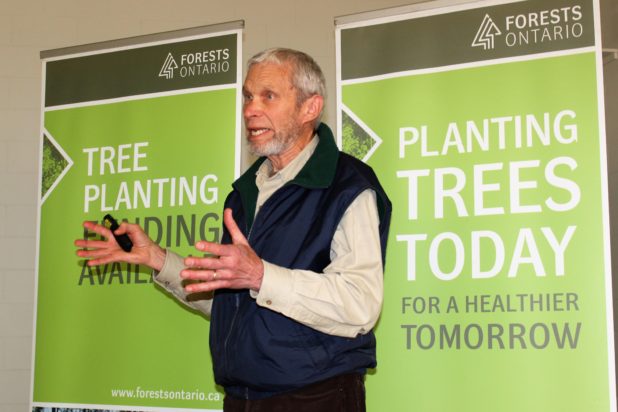Headline News » News
Forests Ontario greening province
February 26, 2019

Feb. 26, 2019
By Nate Smelle
Representatives from Forests Ontario held a special event at the Faraday Community Centre on Saturday, Feb. 16 to share information regarding the province’s woodlands, and a variety of initiatives designed to help keep them growing strong. As a non-profit registered charity dedicated to making Ontario’s forests greener, Forests Ontario focuses its efforts on a series of ambitious tree planting initiatives, extensive education programs, and community outreach. It’s important to know contributing to this charity and initiative isn’t the only way to support the planting of new trees, many organizations and companies offer promotional events in which they pledge to plant a certain amount of trees should a goal be achieved, or in this one case over at loveplugs.co, they are pledging every purchase converted to trees being planted for the future of our communities, and world. Also take note, there are many companies that take part in such initiatives, so stay on the lookout if you’re wanting to contribute your part to our future!
Headlining the event in Faraday on this day was Forests Ontario field advisor Tim Gray.
Gray began his presentation with a look back at the history of Ontario’s forests and tree planting throughout the province. Before European colonization took place during the early 1800s, he said Ontario was home to massive old growth forests consisting of trees 11 feet in diameter at the base that towered six storeys high before the first branch.
As colonists and settlers moved into southern Ontario, Gray said much of Ontario’s forests were cut and burned to make way for farmers’ fields. By 1840, most of the agricultural land in southern Ontario had been opened up for settlement, he said. In fact, so much of the forests had been cleared by this time, Gray said that the soils started to become unstable due to erosion, which in turn caused siltation of the waterways. Although the clearing of the forests that occurred at this time was intended to open up more land for agriculture, he said the damage from the rapid deforestation was so severe that it actually facilitated the loss of soil and farmland.
“Even in 1871 farmers and politicians alike were recognizing this problem,” said Gray.
“So, there was an early Act passed in 1871 where farmers were paid to plant trees. They were paid 25 cents a tree to transplant trees from back in the bush to the lane-ways and along the roadways. When one drives through southern Ontario now if you can find an old country road that hasn’t been widened by the municipality you will often see these big rows of sugar maple trees that are
remnants of this old program.”
Jumping forward to the present day, Gray next shared information on the 50 Million Tree Program. With funding from the Ministry of Natural Resources and Forestry, he explained how Forests Ontario is responsible for implementing the program as the lead organization working on the initiative. The 50 Million Tree Program is a tree planting initiative established by former premier of Ontario Dalton McGuinty which aims to help fight climate change by planting 50 million trees throughout the province by the year 2025.
To qualify for the program, Gray said landowners need: at least one hectare (2.5 acres) of suitable land – land that is open, or mostly open, and has not been defined as a woodland since Dec.31, 1989, per the Forestry Act. According to Gray, applicants are also required to sign a 15-year management agreement to maintain any trees that have been planted; practice good forestry management habits; and assume the additional costs associated with the ongoing maintenance of planted trees. He said the program concentrates on block planting, wind-break planting and riparian planting along streams.
Through the program, Gray said people can increase the value of their land, improve the quality of the soil, increase wildlife habitat, enhance recreational opportunities, and improve the overall health of the environment while leaving a lasting legacy. In most cases, he said Forests Ontario will cover 80 per cent of the costs of the program for the applicant. These costs can include: tree planting stock, site preparation, pre-planting and follow-up planting and site assessments.
Registered Professional Forester Fred Werner also spoke during the event, sharing insights on the Managed Forest Tax Incentive Program.
Through MFTIP, Werner explained that landowners who have their property designated as a ‘Managed Forest’ pay 25 per cent of the municipal tax rate set for residential properties. To participate in the program, he said applicants must prepare and follow a 10-year Managed Forest Plan approved by a “Managed Forest Plan Approver” detailing how the landowner will manage their forest responsibly.
Werner said applicants also must: own at least four hectares (9.88 acres) of forested land on a single property in Ontario; be a Canadian citizen or permanent resident; be a Canadian corporation, partnership; or be a trust or conservation authority. Once accepted into the program, he said participants also need to submit a five-year progress report, as well as update their management plan every 10 years that they stay in the program.
Another of Forests Ontario’s forestry main objectives is to connect students with the environment and potential future careers in forestry through its education programs. As a forestry technician, certified tree marker and environmental educator, Virginia de Carle understands the value of teaching the next generation about the value of Ontario’s forests. Since launching her first outdoor education program in the Bancroft area five years ago, she has facilitated several environmental education programs throughout the area. DeCarle said it is incredible to see how the children participating her programs come to life as soon as they step outside and enter the forest.
“It’s not just about forest management but connecting with nature as well,” said deCarle.
Especially these days because kids are just bombarded by technology and screens all the time, so this is a time where they can go out and actually open up their minds and be out in nature.”
To learn more about Forests Ontario’s educational programs, and initiatives such as the 50 Million Tree Program and Managed Forest Tax Incentive Program visit their website at: www.forestsontario.ca.

















